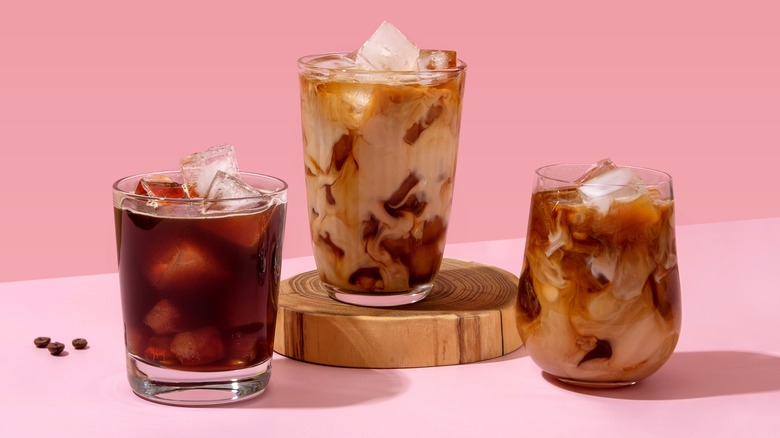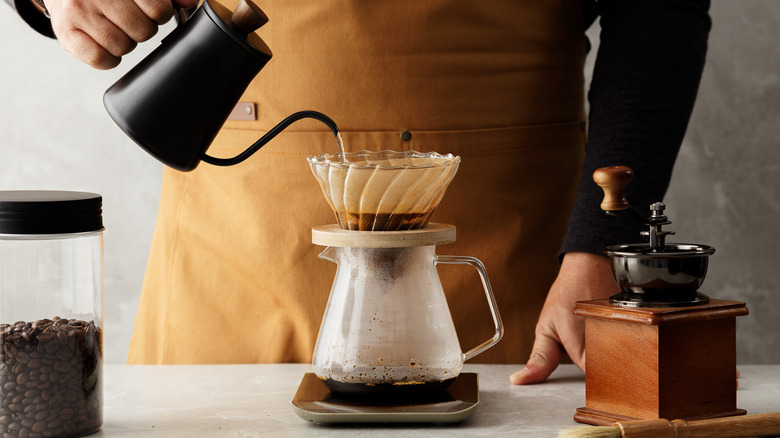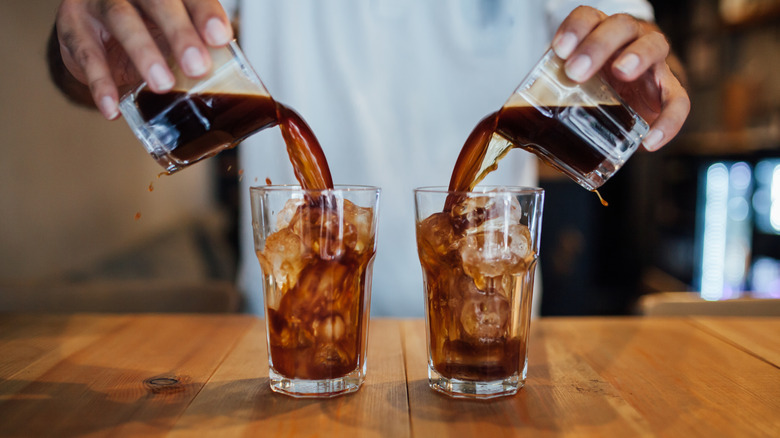The Water Ratio Mistake That's Breaking Your Iced Coffee
Whether you enjoy your iced coffee with heavy cream and plenty of sugar, oat milk and lavender syrup, or simply black and refreshing, the beverage is really nothing without a quality brew. You can load it up with various flavorings and milk, but if the coffee itself isn't good, your iced coffee is going to be mediocre at best. All the fun additional ingredients should be used to elevate the beverage, not mask the taste of bad coffee. While you could leave it to the professionals, that option can hit your wallet hard. With a little attention to detail, you can make excellent iced coffee right from the comfort of your own kitchen.
Aside from choosing high-quality beans, getting the water ratio right is super important for creating a great base, whether you're using a pour-over funnel, French press, standard drip coffee machine, or a fancy Chemex setup. Both too much and too little water can significantly impact the end result. If your coffee is too weak, it won't hold up to sweeteners, milk, and ice. If it's too bitter, the drink will be unpalatable. A good starting point, depending on the coffee's flavor, your personal preferences, and the brewing method, is to use approximately one to two tablespoons of coffee for every six ounces of water. Once brewed, simply pour the coffee over ice. Alternatively, you can also make coffee for your favorite iced latte using the cold brew method.
How much water should you use?
Since you'll be drinking the coffee over ice, it's advisable to brew it a bit stronger to compensate for dilution. As hot coffee cools, particularly if it's refrigerated, its taste can become flatter and more acidic. For this reason, some baristas recommend pouring extra-strong hot coffee over ice immediately. Others suggest allowing the coffee to cool to room temperature before adding ice, arguing that this method yields a more balanced flavor compared to the quickly diluted alternative. Really, it all comes down to your personal preference!
Though you don't absolutely need a scale to make a good cup of coffee, experts in the field generally recommend using one. Utilizing a scale yields more consistent results, as factors like moisture content in the beans, grind size, and freshness can all affect the coffee's volume. If you can control for weight, you can more accurately pinpoint why you didn't like a particular brew. Did you use too much or too little water or coffee, or was the variety, blend, or type of roast creating an undesirable flavor? If you're aiming for precision, begin with a ratio of 50 to 60 grams of coffee to one liter of water.
What about cold brew?
Cold brew and hot-brewed coffee do indeed have really different flavors; the same beans can yield distinctly unique tastes depending on the brewing method. If you opt for cold brew for your iced coffees, planning in advance is necessary. Cold brew can be made by steeping one part coarse-ground coffee in eight parts cold water, usually for up to 24 hours. You'll need a large, non-reactive container like a big glass jar, or you can make cold brew at home using a whipping siphon. To strain the brew effectively, you'll also require something like a very fine mesh strainer, coffee filter, or cheesecloth. Alternatively, you can make a small batch in a French press, which already has a built-in sieve.
In general, cold brew is less acidic and bitter than hot-brewed coffee. Brewing with cold water actually changes the chemicals — and therefore the flavors — that are extracted from the coffee grounds. While cold brew it is not nearly as aromatic as its hot-brewed counterpart, it is still big on flavor, showcasing sweetness, richness, and a smooth texture. The method you choose totally depends on your personal preferences. Whichever path you take, don't breeze past the basics; always pay attention to that water-to-coffee ratio!



